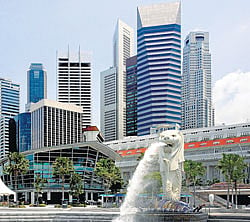
One of Asia’s most sought after destinations, Singapore has grown from being a stop-over city to the new and upcoming tourist hot spot. Maya Jayapal traces this phenomenal transformation.
I lived in Singapore for 13 years. I have also written a book about the old Singapore. And, I have been revisiting the place once every five years. It never ceases to amaze me. Its low key, albeit dramatic founding by Raffles, the sweep of events that led to the creation of the new Singapore by the larger than life size figure of Lee Kuan Yew, the promises he made on the anguishing separation from Malaysia, and its presence on the world stage today, where it is no longer just a stop off point for travellers between Asia and the West, but a place to visit and to live in its own right.
It has encouraged a number of firsts — the first night time Formula One, the first Youth Olympic Games, its promotion as a world class educational hub, as announced by a recent plan to tie up the NUS and Yale University — the list is endless.
It seeks a transformation from being a financial and commercial centre to an artistic and cultural space, something other nations did not ever think would happen. I would notice disparaging remarks by our countrymen about the richness of our heritage and of how Singapore lacks that. Be that as it may, Singapore and its leaders always had a vision. Their vision is being fulfilled in many ways. A recent poetry reading by Gulzar had an audience of a 100 — I wondered whether we could garner that many in our country.
When I left Singapore in 1993, it had its museums, which were well run and well showcased. But now, the vision includes many more museums where world class works are put on display. A friend tells me that the old Supreme Court building and City Hall are being combined to form the largest visual arts space in Asia. According to her, over 120 million dollars have been invested by the government to promote arts and culture.
Galleries, big and small, proliferate. The Singapore Repertory Theatre, founded only as recently as 1993 (part of Singapore’s unspoken and ambitious vision of bringing awareness of the arts) has been successful in attracting talent from across the world. On my last visit in November 2011, I had the opportunity to see Richard the Third as part of the Bridge Project (with the Brooklyn Academy of Music and the Old Vic), which also brought The Winter’s Tale, and the Tempest. It was staged in the Esplanade Theatre on the Esplanade.
The architecture of the theatre has been facetiously described as two armadillos coupling, with their spiky humps on the skyline. Be that as it may, it was the epitome of sophistication that night. Of course, tickets were steep at $180, and that ensured the presence of the crème de la crème of Singapore society, mostly expatriates.
Singapore’s transformation has not been merely skin deep, although it is a cautious transformation. Nothing symbolises this change more than the Singapore River. From being a ‘veritable Charing Cross of shipping’ as described by Charlotte Cameron in 1924, with trade in commodities like gambier, pepper, rattans, sago, tin and tapioca, it is now, although still the hub of commerce, a hub of tourism frequented by suave suited bankers inhabiting mercantile banks with blessings from the Statue of Raffles looking down on them.
With a view to preserving some of the ambience of the bustling river of yore, albeit a trifle blandly, the old shop houses with their teeming five foot ways in front forming a continuous corridor, have been converted into upscale pubs, galleries and restaurants. A similar makeover has been given to the old Telok Ayer Market, which was built in 1824, which is now the Lau Pa Sat Food centre.
The new building was finished in 1894, and has landmark Victorian cast iron frames with intricate filigree ornamentation, which were shipped from Glasgow. Originally, it was the landing place for Chinese and Indian immigrants: now visitors of all races and colours frequent its renowned eating places: a diversity still remains. Change has come about in attitudes, but always with a caveat. ‘Pink Dot Day’ celebrates homosexuality in a city where it is banned, starting in 2009, when a large gathering came together in Hong Lim Park to express freedom in love.
The government has finally allowed casinos, but at a price which is also being extracted from Singaporeans who apparently can get a card for $2,000 which allows them to gamble through the week; a taxi driver whose son has gambled away his earnings woefully told me this.
Singapore is paying in other ways for this accelerating growth and pace of life. The number of depressives is statistically appalling. And the cost of living has spiralled, so much so that my host, who has just turned 70, says that he will have to keep working till he drops, in order to maintain his lifestyle.
However, I came away impressed despite all these Cassandras who were complaining about these issues. It is still an orderly city, with spaces for walkin, with a system for everything, with a security that allows one to return home at midnight without looking over one’s shoulder, where buses and trains run on time.
And if one misses the excitement, or wants to go into a really good book store, or see a really antiquated monument with centuries of history behind it and graffiti on it, one can always come running to India.
